
Cubism is an early-20th-century avant-garde art movement begun in Paris that revolutionized painting and the visual arts, and influenced artistic innovations in music, ballet, literature, and architecture. Cubist subjects are analyzed, broken up, and reassembled in an abstract form—instead of depicting objects from a single perspective, the artist depicts the subject from multiple perspectives to represent the subject in a greater context. Cubism has been considered the most influential art movement of the 20th century. The term cubism is broadly associated with a variety of artworks produced in Paris or near Paris (Puteaux) during the 1910s and throughout the 1920s.

Henri-Robert-Marcel Duchamp was a French painter, sculptor, chess player, and writer whose work is associated with Cubism, Dada, and conceptual art. He is commonly regarded, along with Pablo Picasso and Henri Matisse, as one of the three artists who helped to define the revolutionary developments in the plastic arts in the opening decades of the 20th century, responsible for significant developments in painting and sculpture. He has had an immense impact on 20th- and 21st-century art, and a seminal influence on the development of conceptual art. By the time of World War I, he had rejected the work of many of his fellow artists as "retinal", intended only to please the eye. Instead, he wanted to use art to serve the mind.

Francis Picabia was a French avant-garde painter, writer, filmmaker, magazine publisher, poet, and typographist closely associated with Dada.

Abstract art uses visual language of shape, form, color and line to create a composition which may exist with a degree of independence from visual references in the world.

Las Meninas is a 1656 painting in the Museo del Prado in Madrid, by Diego Velázquez, the leading artist of the Spanish Baroque. It has become one of the most widely analyzed works in Western painting for the way its complex and enigmatic composition raises questions about reality and illusion, and for the uncertain relationship it creates between the viewer and the figures depicted.
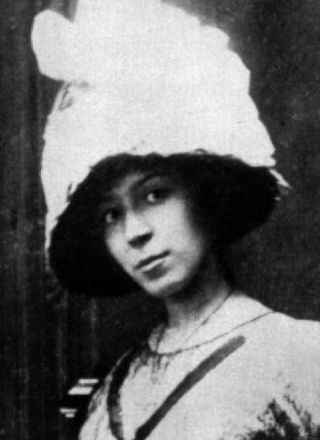
Marie Laurencin was a French painter and printmaker. She became an important figure in the Parisian avant-garde as a member of the Cubists associated with the Section d'Or.

Monochromatic painting has played a significant role in modern and contemporary Western visual art, originating with the early 20th-century European avant-gardes. Artists have explored the non-representational potential of a single color, investigating shifts in value, diversity of texture, and formal nuances as a means of emotional expression, visual investigation into the inherent properties of painting, as well as a starting point for conceptual works. Ranging from geometric abstraction in a variety of mediums to non-representational gestural painting, monochromatic works continue to be an important influence in contemporary art.
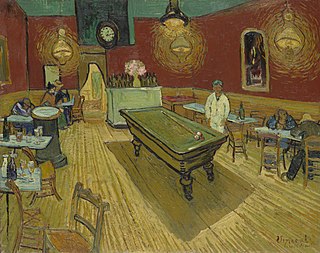
The Night Café is an oil painting created by Dutch artist Vincent van Gogh in September 1888 in Arles. Its title is inscribed lower right beneath the signature. The painting is owned by Yale University and is currently held at the Yale University Art Gallery in New Haven, Connecticut.
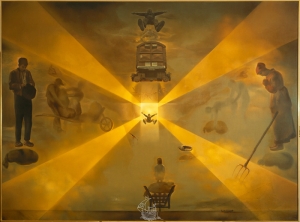
La Gare de Perpignan is a c. 1965 large-scale oil on canvas painting by the Spanish surrealist Salvador Dalí, on display in the Museum Ludwig in Cologne.
Witches' Sabbath or The Great He-Goat are names given to an oil mural by the Spanish artist Francisco Goya, completed sometime between 1821 and 1823. It evokes themes of violence, intimidation, ageing and death; Satan hulks in the form of a goat in moonlit silhouette over a coven of terrified old witches. Goya was then around 75 years old, living alone and suffering from acute mental and physical distress.
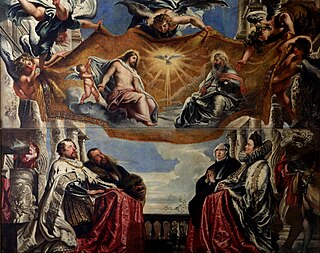
The Gonzaga Family in Adoration of the Holy Trinity is a painting by the Flemish artist Peter Paul Rubens, housed in the Ducal Palace in Mantua, Italy. The work was commissioned by Duke Vincenzo I Gonzaga for the Jesuit church in Mantua, while Rubens was his court painter.

Dancer in a Café is an oil painting created in 1912 by the French artist and theorist Jean Metzinger. The work was created while Metzinger and Albert Gleizes, in preparation for the Salon de la Section d'Or, were publishing, Du "Cubisme", the first major defense of the Cubist movement, and it was first displayed at the 1912 Salon d'Automne in Paris. The work proved controversial within the Municipal Council of Paris, causing debate in the Chambre des Députés about the use of public funds to exhibit such 'barbaric' art, with the Cubists being defended by the Socialist deputy Marcel Sembat.

The Cathedral (Katedrála) is an abstract painting created by Czech artist František Kupka in 1912–13. The medium is oil on canvas, and the painting’s dimensions are 180 × 150 cm. The painting is a part of the permanent Jan and Meda Mládek collection of Museum Kampa in Prague, Czech Republic. This painting is one of a series of abstract works that Kupka termed Vertical and Diagonal Planes. Vertical lines, running the entire length of the canvas are intersected by diagonal lines to form rectilinear shapes of various sizes. The diagonal lines run from the top left to the bottom right and from the top right to the bottom left of the painting. These rectilinear shapes are composed of blocks of black, white, and a range of blue, red, purple, gray, and brown color. The large black space between the two clusters of the shapes, and the arching of the top of the right cluster, brings to the viewer’s mind two stained glass windows illuminated by light in a dark cathedral.

Les Peintres Cubistes, Méditations Esthétiques, is a book written by Guillaume Apollinaire between 1905 and 1912, published in 1913. This was the third major text on Cubism; following Du "Cubisme" by Albert Gleizes and Jean Metzinger (1912); and André Salmon, Histoire anecdotique du cubisme (1912).
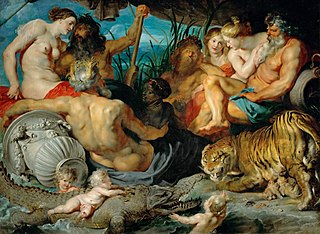
The Four Continents, also known as The Four Rivers of Paradiseor The Four Corners of the World, is a painting by Flemish artist Peter Paul Rubens, made between 1612 and 1615. Rubens painted this piece during a time of truce in the Eighty Years' War known as the Twelve Years' Truce. The painting depicts the female personifications of the four continents with the male personifications of their respective major rivers. The painting also depicts three putti in the foreground along with a crocodile, tigress, and her three cubs. An important figure in this piece is the woman in the middle who personifies Africa. She was one of the two black women Rubens painted at the time.
Elizabeth Murray, born Elizabeth Heaphy, was a British watercolourist. She primarily painted portraits and landscapes of the Canary Islands, where she lived for ten years. She was a member of the Royal Institute of Painters in Water Colours, and was one of the founders of The Society of Female Artists in London in 1857.
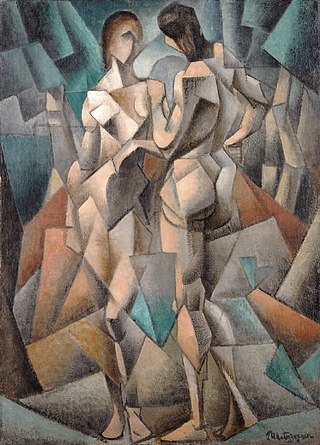
Galeries Dalmau was an art gallery in Barcelona, Spain, from 1906 to 1930. The gallery was founded and managed by the Symbolist painter and restorer Josep Dalmau i Rafel. The aim was to promote, import and export avant-garde artistic talent. Dalmau is credited for having launched avant-garde art in Spain.

Saint John the Baptist Preaching is a 1562 oil-on-canvas painting of John the Baptist by Paolo Veronese, now in the Galleria Borghese in Rome. The painting depicts John the Baptist acting primarily and quite literally as a messenger for the coming of Jesus.

Madame Georges Charpentier and Her Children is an 1878 oil on canvas painting by Pierre-Auguste Renoir. It depicts Marguerite Charpentier, a French salonist, art collector, and advocate of the Impressionists, and her children Georgette and Paul. The painting is held by the Metropolitan Museum of Art.

Animal Trainer is an enamel on canvas painting by the French painter Francis Picabia, created in 1923. It is held at the Musée National d'Art Moderne, in Paris.


















